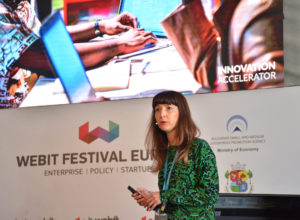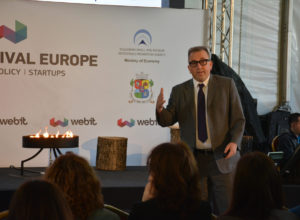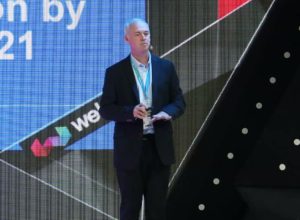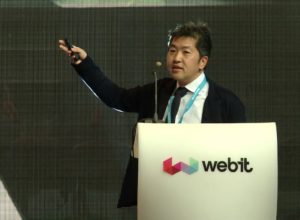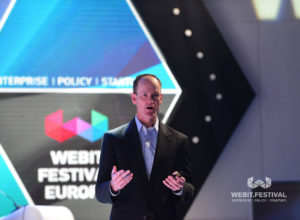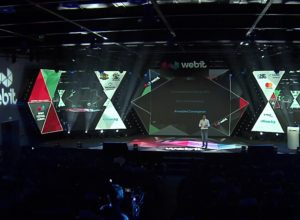Tag: Webit
Audi transforms driving time into a personal experience with its 25th...
The 25th Hour Project of the German automobile manufacturer aims to research and understand how the self-driving cars of the future could restore the time we spend in commuting.
Autonomous automobiles are bound to disrupt the urban mobility as we know it largely due to the combination of three very important trends. Computer vision is finally good enough to recognize objects on the road and to build 3D maps of the surrounding area. A ride-sharing, self-driving model will enable companies to cut costs from hiring drivers. Lastly, electrification will make the cost of maintenance of the vehicle lower and it will benefit the environment.
Self-driving cars are expected to not only make people's lives easier, but also to make roads much safer. According to KPMG, only in the UK autonomous cars will lead to 2,500 fewer deaths between 2014 and 2030.
Currently, only some of the driver’s tasks are automated. Next year, it is expected for the car to take control on motorways while the driver is ready to take over if needed and is still required for many situations. According to the motor industry, in eight years cars should be able to drive entirely on their own with the driver only supervising the process. It is estimated that from 2030 drivers will no longer be necessary and cars will be completely autonomous.
Americans spend approximately 50 minutes a day in their car. Audi aims to take this necessity time and develop autonomous cars which will be able to convert it into productive time for work, quality time spent with family and friends or into time to relax while watching a movie or playing a video game.
Audi is still at the stage of testing how volunteers react to three major stimuli - light, sound and the frequency and density of information which is displayed on the screens in the car. Participants ride inside Audi’s simulated autonomous car which has four seats facing each other, large projection screens on all sides and no steering wheel.
The company should consider how to implement commercials in a more elegant way in its premium car range because in-car advertising is inevitable. Especially when the car’s connectivity will shape the whole autonomous driving experience. According to Audi, the car will reach its full potential only when it becomes part of a completely networked road system which will enable the automated Audi cars to communicate to each other and to the nearby infrastructure, shops and restaurants. As the head of culture and trend communication at Audi Melanie Goldmann said:
“The car is going to be the ultimate mobile device.”The car will adapt to the person using it by learning their habits and making suggestions based on the gathered information. This data collection could help turn the car into an even more productive space than the office itself. As far as privacy is concerned, Audi will store the data in the cloud rather than in the car. The research showed that productivity time is well developed and down time can be easily recreated in the car. The situation with quality time is different because it is extremely personal to each consumer. Therefore, Audi should collect as much data as possible about the life of the person in order to be able to predict and meet their needs. If you are interested in the latest news about Self-driving Vehicles, then Webit.Festival Europe is the right place for you. During the Mobility Summit, you can listen to top level speakers such as the following who have attended Webit before: the Investment Principal at the European BMW i Ventures team Sohaila Ouffata, the Regional General Manager EMEA of Uber Jambu Palaniappan and the CEO of Hyperloop Transportation Technologies Dirk Ahlborn. Here you can get more information about Webit.Festival, while here you can get all the information you need about the tickets for the event.
Innovation should be used to find a solution to world hunger
As surprisingly as it might sound, in 2017 one in every nine people is deprived from access to a nutritious meal on a daily basis.
There are different reasons behind this phenomenon. Natural disasters caused by climate change affect the most vulnerable people around the globe. One major consequence of conflict is hunger. The big conflict in the Middle East affects not only Syria, but also its neighbouring countries - Lebanon, Jordan and Turkey.
In reality, 20 million people worldwide are on the break of famine. During Webit.Festival Europe 2017 the Private Sector Partnerships and Innovation Accelerator Lead at World Food Programme Hila Cohen talked about how innovation can be used to reach the sustainable development goal of zero hunger.
The World Food Programme is a United Nations agency which delivers food to people who need it the most. Trucks, ships and aircraft supply food to 80 million people a year in the most remote locations in the world. The World Food Programme needs partners like NGOs, governments and the private sector in order to find a solution to world hunger.
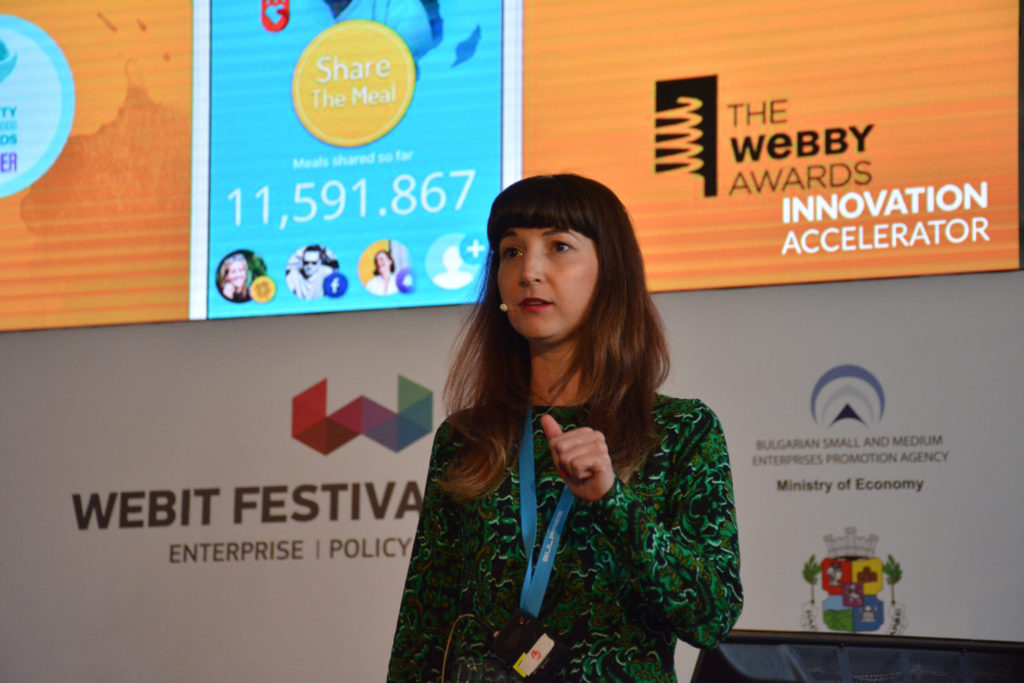 The Private Sector Partnerships and Innovation Accelerator Lead at World Food Programme Hila Cohen[/caption]
The agency has developed an app called ShareTheMeal, which takes advantage of the fact that there are more people with mobile phones than hungry people on the planet. With the app, you can donate 50 cents at a time and feed a child for a day. Up to today thanks to 50 cents donations, more than 12 million people have been fed.
Food for Tech is another project which aims to empower refugees by giving them tech skills. The idea is that these skills can be used at the current location of the refugees but also at other places they go as they migrate. The World Food Programme is looking into self-driving trucks which will be able to cope with the challenges of places where there is no real roads or a secure Internet connection.
The Private Sector Partnerships and Innovation Accelerator Lead at World Food Programme Hila Cohen[/caption]
The agency has developed an app called ShareTheMeal, which takes advantage of the fact that there are more people with mobile phones than hungry people on the planet. With the app, you can donate 50 cents at a time and feed a child for a day. Up to today thanks to 50 cents donations, more than 12 million people have been fed.
Food for Tech is another project which aims to empower refugees by giving them tech skills. The idea is that these skills can be used at the current location of the refugees but also at other places they go as they migrate. The World Food Programme is looking into self-driving trucks which will be able to cope with the challenges of places where there is no real roads or a secure Internet connection.
“Stopping world hunger is not something we can do on our own.”, Hila Cohen said.When the location of the delivery is very hard to reach, the food is dropped from the aircraft. In the case of an existing food market, a cash-based transfer is applied. People receive credit cards, a SMS system or paper vouchers which enable them to go to the market and select and buy their own food. The World Food Programme contributes to the education system’s development by introducing the school feeding concept. The idea behind it is to give food to children in schools, which would mean parents will not have to decide between sending their child to school or to work.
“Even though the world population is growing, the number of hungry people is diminishing.”, Cohen said.Regardless of this positive trend, if actions are not taken by 2030 the hungry people worldwide are estimated to be around half a billion. By opening the World Food Programme Innovation Accelerator, the agency is counting on technological innovation to help make these numbers go down. Startups related to food can receive funding and access to the field from the Innovation Accelerator. The variety of countries in which the World Food Programme operates, gives startups a great opportunity to get acquainted with a different ecosystem. [caption id="attachment_5131" align="aligncenter" width="640"]
 The Private Sector Partnerships and Innovation Accelerator Lead at World Food Programme Hila Cohen[/caption]
The agency has developed an app called ShareTheMeal, which takes advantage of the fact that there are more people with mobile phones than hungry people on the planet. With the app, you can donate 50 cents at a time and feed a child for a day. Up to today thanks to 50 cents donations, more than 12 million people have been fed.
Food for Tech is another project which aims to empower refugees by giving them tech skills. The idea is that these skills can be used at the current location of the refugees but also at other places they go as they migrate. The World Food Programme is looking into self-driving trucks which will be able to cope with the challenges of places where there is no real roads or a secure Internet connection.
The Private Sector Partnerships and Innovation Accelerator Lead at World Food Programme Hila Cohen[/caption]
The agency has developed an app called ShareTheMeal, which takes advantage of the fact that there are more people with mobile phones than hungry people on the planet. With the app, you can donate 50 cents at a time and feed a child for a day. Up to today thanks to 50 cents donations, more than 12 million people have been fed.
Food for Tech is another project which aims to empower refugees by giving them tech skills. The idea is that these skills can be used at the current location of the refugees but also at other places they go as they migrate. The World Food Programme is looking into self-driving trucks which will be able to cope with the challenges of places where there is no real roads or a secure Internet connection.
“That’s how we are dreaming. We dream big.”, Cohen said.Hydroponics is another area of interest for the agency. It enables people to grow food without soil by using water, minerals and a manageable ecosystem. The World Food Programme is testing to use the Blockchain technology to transfer money from the organisation to the people in need. You can watch her full lecture here: If you want to keep up with the latest trends in the world of digital economy and technology, then Webit.Festival is the right place for you. Visit our website and book 2 in 1 of our Super Earlybird tickets for Webit.Festival Europe 2018. Feel the Webit vibe with some of the best photos from this year’s event! [easingslider id="4954"]
Tesla will build the world’s largest lithium-ion battery in South Australia
Tesla, together with the French renewable energy provider Neoen and the South Australian government will install the world’s largest lithium-ion battery to ensure energy security for South Australia in the future.
The future of the energy industry is defined by renewable energy sources and energy storage technologies. The shift towards cleaner and more sustainable alternatives enables energy storage systems to become more largely used. They store the renewable energy which can be then used during peak hours to prevent blackouts.
The lithium-ion battery storage is expected to continue to dominate the market as well as to be a leader with regards to the increase of demand and the decrease of costs. This market position is a result of battery systems which meet the needs of the fastest growing utilities sector. Research shows that in 2017 around 76 percent of the energy storage market will account for utilities.
Tesla will provide a 100 MW/129 MWh Powerpack system which will store the energy produced by Neoen’s Hornsdale Wind Farm situated near Jamestown, South Australia. Last September, a storm caused blackout which affected the entire state of South Australia and left 1.7 million people without electricity. Tesla Powerpack aims to use the stored renewable energy from the wind farm to solve and prevent power shortages.
By delivering electricity during the peak hours this grid scale energy storage project will improve the reliability of the electrical infrastructure in South Australia. The system is expected to be completed by December 2017. It will be the largest lithium-ion battery storage project worldwide which will be able to provide electricity to more than 30,000 homes.
“The system will be three times more powerful than any system on Earth. This is not a minor foray into the frontier. This is going three times further than anyone has gone before.”, Elon Musk said.This project aims to ensure energy security for the people of South Australia. It empowers the state to take the lead on its energy future, but it also sets an example by making a step forward towards the adoption of sustainable energy around the world. The global COO of Neoen Romain Desrousseaux shared that this project is the right way to introduce sustainable and reliable energy that is cheap to the residents of South Australia. By generating around 1,050,000 MWh of renewable electricity annually, the wind farm is the largest renewable energy generator in South Australia.
“We are creating dispatchable, renewable energy that is the cheapest source of energy in Australia and most places in the world.”, Desrousseaux said.If you are interested in the latest trends in Sustainable Energy, then Webit.Festival Europe is the right place for you. During the Smart Cities Summit, you can listen to top level speakers such as the following who attended Webit before: the Strategist Energy Transition at Alliander Manon Jutte, the Interim Head of Urban Living and Built Environment Mike Pitts who led on embedding sustainability across Innovate UK’s strategy and programmes and the Vice President and Chief Technology Officer for EMEA at VMware Joe Baguley. Here you can get more information about Webit.Festival, while here you can get all the information you need about the tickets for the event.
Huge opportunities for investors and entrepreneurs in the Space Industry
Currently, the global infrastructure is expanding into Space. The truth is, this is something that has already started happening. The commercial activity in Space creates many opportunities for both investors and entrepreneurs. It is expected to exceed government activity by 2020.
At the 2017 edition of Webit.Festival Europe the Chairman of Space Angels Network Joe Landon talked about the entrepreneurial revolution in Space. Space Angels is a company which searches the world for the best space startups. It aims to create opportunities for the investors while enabling them to make profit from the commercial space industry.
No matter what the industry is, new technology is always considered crazy at first. The Space was once considered science fiction, now it is a science fact. To make the topic more tangible, Joe Landon shared a couple of examples of innovations in the Space industry with the audience at Webit.
The Falcon-9 Rocket was launched, landed and re-launched by SpaceX. Such reusable rockets spread the costs over the multiple launches and present a revolution in the Space industry. The Blue Origin - the space company of Jeff Bezos, the CEO of Amazon, had a similar success with its New Shepard suborbital rocket. It was launched and landed five times in a year.
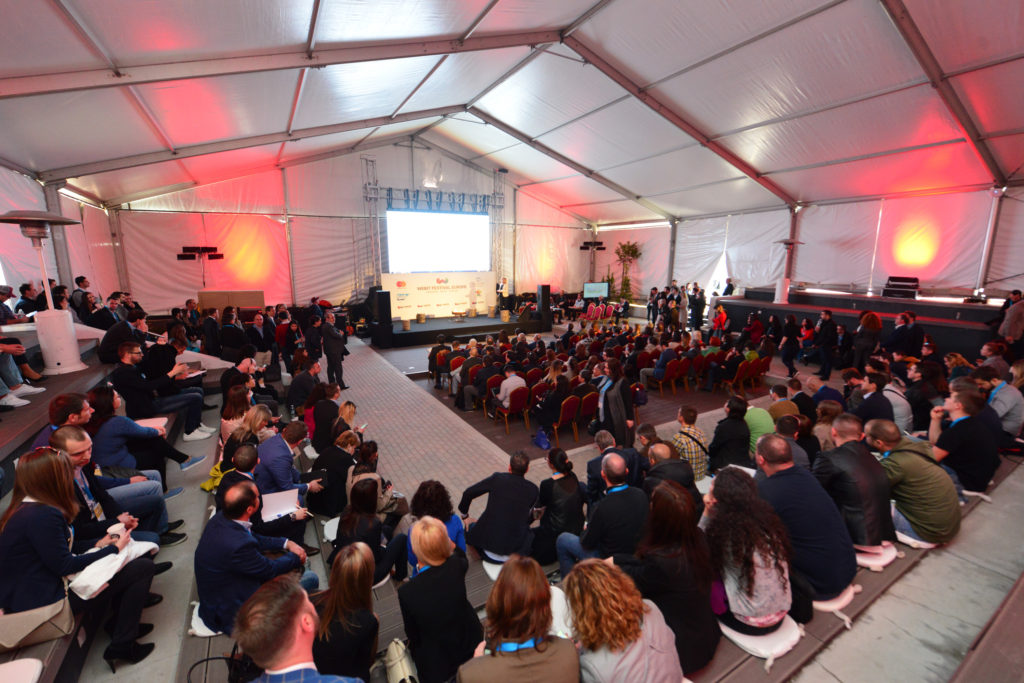 There are many forces which when acting together make Space innovations possible. Joe Landon stressed on the importance of the development in technology which reduces the costs of sending things to the Space. He emphasized on the role of the revolution in satellite technology.
Commercial communication satellites a couple of years back were very heavy and extremely expensive to make and launch. It was important for these satellites to last for 15 years and to be very reliable which required further financing.
The satellites from today can be held in a person’s hand and are far cheaper to produce and launch than their multi-million spacecraft predecessor. It is possible to launch dozens of them at the same time. This technology has a great impact on the space economy. Huge opportunities for investors and entrepreneurs arise.
There are many forces which when acting together make Space innovations possible. Joe Landon stressed on the importance of the development in technology which reduces the costs of sending things to the Space. He emphasized on the role of the revolution in satellite technology.
Commercial communication satellites a couple of years back were very heavy and extremely expensive to make and launch. It was important for these satellites to last for 15 years and to be very reliable which required further financing.
The satellites from today can be held in a person’s hand and are far cheaper to produce and launch than their multi-million spacecraft predecessor. It is possible to launch dozens of them at the same time. This technology has a great impact on the space economy. Huge opportunities for investors and entrepreneurs arise.
“Reusability in Space is very important.”, Landon said.There are innovations concerning 3D printing in Space. The company Made-in Space created a zero gravity 3D printer which enables the astronauts to print the exact tool they need in Space which lowers the costs. 3D Systems is a company which created the first manufactured object from asteroid material. The European banking center created $227 million fund to invest in space mining projects. According to a research report on the opportunities in the commercial space economy by Goldman Sachs, the costs of asteroid mining are comparable to these in Earth mines.
 There are many forces which when acting together make Space innovations possible. Joe Landon stressed on the importance of the development in technology which reduces the costs of sending things to the Space. He emphasized on the role of the revolution in satellite technology.
Commercial communication satellites a couple of years back were very heavy and extremely expensive to make and launch. It was important for these satellites to last for 15 years and to be very reliable which required further financing.
The satellites from today can be held in a person’s hand and are far cheaper to produce and launch than their multi-million spacecraft predecessor. It is possible to launch dozens of them at the same time. This technology has a great impact on the space economy. Huge opportunities for investors and entrepreneurs arise.
There are many forces which when acting together make Space innovations possible. Joe Landon stressed on the importance of the development in technology which reduces the costs of sending things to the Space. He emphasized on the role of the revolution in satellite technology.
Commercial communication satellites a couple of years back were very heavy and extremely expensive to make and launch. It was important for these satellites to last for 15 years and to be very reliable which required further financing.
The satellites from today can be held in a person’s hand and are far cheaper to produce and launch than their multi-million spacecraft predecessor. It is possible to launch dozens of them at the same time. This technology has a great impact on the space economy. Huge opportunities for investors and entrepreneurs arise.
“In ten years satellites will cost 10,000 times less, they will have 1,000 times lower mass and the launch will cost 350 times less.”, Joe Landon said.He dispelled the myth that space companies need extremely big investments in comparison to other tech companies. In fact, the seeds and Series-A investment in space startups is identical to the rest of the tech market. The truth is that space companies from the past needed a lot of funding to build the expensive infrastructure which the space companies of today use. This advantage enables them to develop low-cost, quick businesses. Another myth is that space companies take too long before making any actual profit. The numbers show that since 2009 $14 billion were accounted as exits in the Space industry.
“In the future we’d like to think there are millions of people living and working in the Space.”, Landon said.We are not talking about sending only missions to the Space, but also forming communities. Astronauts will be joined by people with all kind of expertise such as teachers, lawyers and doctors. Today, very few people go to Space. According to Landon in one or two generations there will be people who have lived their entire life only in the Space. This completely different perspective when the Earth is observed from the Space can change the way we think about it. As the Apollo 14 astronaut Edgar Mitchell said:
“You develop an instant global consciousness, a people orientation, an intense dissatisfaction with the state of the world, and a compulsion to do something about it.”You can watch his full lecture here: If you want to keep up with the latest trends in the world of digital economy and technology, then Webit.Festival is the right place for you. Visit our website and book 2 in 1 of our Super Earlybird tickets for Webit.Festival Europe 2018. Feel the Webit vibe with some of the best photos from this year’s event! [easingslider id="4954"]
The need for ethical practices in AI
Nowadays, we have access to two things. First, a big amount of data about our personal information and second - access to AI which enables us to understand far better the insights that make us who we are.
At the 2017 edition of Webit.Festival Europe the President and Global Brand Director of Havas Worldwide Jason Jercinovic, introduced the topic of ethics in the Artificial Intelligence because if this data is in the wrong hands, our privacy could be endangered.
An ethical imperative on how to use this data is necessary to be created. We should consider ethics from the perspective of both consumers and professionals to communicate in an informed way while considering the benefits and the risks which AI brings.
Jason Jercinovic stressed on the development of the tools of today which compared to those of the past can recognize unstructured data. The truth is the world of social media and interconnected devices is one of unstructured data. And these tools enable us to understand the insights from that unstructured data at a scale and to work with them.
[caption id="attachment_5137" align="aligncenter" width="640"]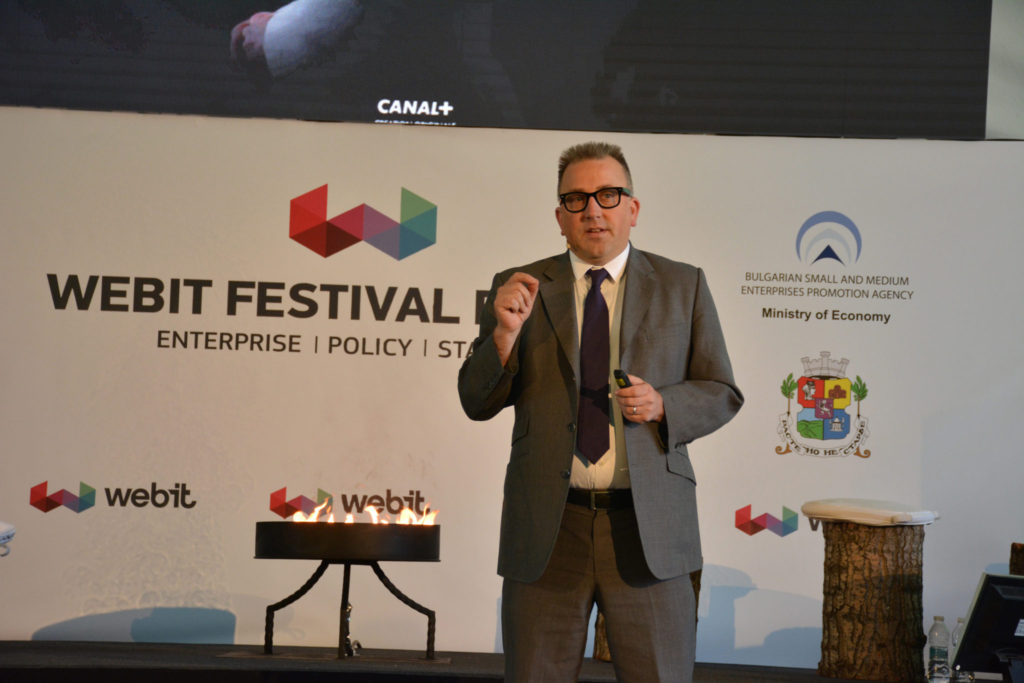 The President and Global Brand Director of Havas Worldwide Jason Jercinovic[/caption]
The vast amount of data enables us to understand people’s behaviour in great detail. Furthermore, it allows us to create and deliver experiences which are extremely efficient since they are targeted to each individual based on personal preferences.
The President and Global Brand Director of Havas Worldwide Jason Jercinovic[/caption]
The vast amount of data enables us to understand people’s behaviour in great detail. Furthermore, it allows us to create and deliver experiences which are extremely efficient since they are targeted to each individual based on personal preferences.
 The President and Global Brand Director of Havas Worldwide Jason Jercinovic[/caption]
The vast amount of data enables us to understand people’s behaviour in great detail. Furthermore, it allows us to create and deliver experiences which are extremely efficient since they are targeted to each individual based on personal preferences.
The President and Global Brand Director of Havas Worldwide Jason Jercinovic[/caption]
The vast amount of data enables us to understand people’s behaviour in great detail. Furthermore, it allows us to create and deliver experiences which are extremely efficient since they are targeted to each individual based on personal preferences.
“With that information I can predict the future. I can influence how you think.”, Jercinovic said.This technology is becoming more complex at a very fast pace. The reality is that companies are willing to use our personal information in order to target their products or services more precisely. Whether we accept this approach as ethical or not will not change the current situation. That is why, we need a code of conduct. At the end of his talk, Jason Jercinovic underlined once again the importance of making a difference between the benefits and the risks AI brings. It is no secret that this technology is used by companies to deliver high quality content and products to us, customers. AI is present in most parts of our live and it is here to make it better. To get a real idea of how AI is implemented in our daily life you can find more about eagleAi, an intelligence platform created by Havas Cognitive for ITV News. It aims to understand how consumers think and it was used during the USA elections. eagleAi processes a huge amount of posts, comments, tweets, news articles, debates and many more to determine what people are talking about and which issues they do find relevant. AiMEN is a cognitive social listening tool created by Havas Cognitive which with the help of AI discovers the posts of people who leave negative comments on the Internet and responds to them with quotes from the Bible. You can watch his full lecture here: If you want to keep up with the latest trends in the world of digital economy and technology, then Webit.Festival is the right place for you. Visit our website and book 2 in 1 of our Super Earlybird tickets for Webit.Festival Europe 2018. Feel the Webit vibe with some of the best photos from this year’s event! [easingslider id="4954"]
There will be 48 billion IoT devices by 2021 and 30%...
Bluetooth technology is developing with steady pace to satisfy customers, said industry veteran Martin Wooley from Webit.Festival Europe 2017 stage. He is Technical Program Manager EMEA for Bluetooth Segway - the standard body behind Bluetooth technology and told us how the company is regularly improving the range and the transfer speed of its devices.
"Back in the 1990’s there were a billion devices connected to the internet. But only 10 years later their number doubled to 2 billion largely thanks to the smartphones. The forecast for 2021 though is staggering. 48 billion devices will be connected to the Internet and 30% of them will be Bluetooth devices. This is not coincidence - Bluetooth has been systematically developed over the years to keep pace with the market requirements and and to enable new things. And it has become a key enable of the Internet of Things (IoT)", Mr Wooley said, when talking about the future of the IoT industry.
He explained how Bluetooth is now heavily used in the medical and fitness industries rather than just being replacement for cable.
"In the beginning Bluetooth was a cable-replacement technology that gave us wireless mice and keyboards and some great audio solutions. Wind the clock forward to 2020 and Bluetooth Low Energy is in pretty much every smartphone and tablet on the planet. It also gave rise to medical devices, health and fitness devices, wearable technology and so on. More recently Bluetooth 5 was released. The headline changes we have made were that we’ve made it twice as fast, we increased the range by a factor of 4 and the capacity of broadcasting data was increased by a factor of 8", the expert said.
He also explained more about the bluetooth beacons used more and more by huge businesses.
"You can use Bluetooth devices in two ways. They can either connect to each other and exchange data over the connection or they can work in a connection-less way, with one device just broadcasting data that any other device can see. Beacons are prime use case for the application of this broadcasting capabilities and the numbers are really interesting. Over the last couple of years we have shifted from companies that are running small pilot projects to rolling out serious deployments of beacons into their businesses and the forecasts are amazing. By 2021 the estimates are that there will be more than 500 million beacons shipped in that one year alone", Mr Wooley expects.
This is how edtech is changing college exams in Japan
Norihisa Wada, the CMO of Tokyo-based Edulab, Inc., an edtech leader with a strong basis in assessment and learning science, took the Webit.Festival Europe 2017 stage by storm to tell us more about the latest innovations in educations in Japan. Mr Wada, who is a former SVP Nintendo, also teaches students in Kyoto University in the field of behavior change.
Meanwhile, EduLab is providing new technology to help for better assessments in education, for example voice and handwriting recognition, which will help for better evaluation of the learners. This will impact the college entrance exams in Japan, starting in 2020.
"In year 2020 the college entrance exams will change. One big change is going from multiple choice questions test to an essay based question items. The second will be the English assessment areas. In Japan the two components were listening and reading, but we are going to add speaking and writing. These are the areas where we provide new technology like the voice recognition and handwritten technology to give a fine assessment of the learners. The national assessment in Japan is multiple choice. This will change into four spectrum assessment. You need to look into your personal characteristics. What are the creativeness you have", the expert said.
He also explained about the nature of the four spectrum assessment:
"First generation is computer based assessment. Second generation is what you call an adaptive learning assessment system. And third generation is what you call a formative assessment, where assessment technology is integrated into the learning process itself. The fourth generation is what you call a four spectrum analysis - assessment of both cognitive and non-cognitive skills".
Mr Wada and his company are also open to investing in startups in the education industry.
"We do a lot of investments today in the field of education technology. My work is connected to meeting new venture startups in the education area in which we could invest in the future. We have outposts throughout the world and these are the trends that we see today in the assessment field of education in Japan", he said.
Edge computing through IoT is the future
Eric Klinker, former CEO of Bittorent and now Chief Executive Officer of Resilio Inc, was again among the top speakers at Webit.Festival Europe 2017 in Sofia. Mr Klinker now heads Resilio, spin-off of Bittorent, aiming to empower the IT administrator with world leading technologies to handle the ever expanding demands of moving big data reliably and fast over any network to any number of endpoints.
Cloud computing is now a huge part of our personal lives as we use it for storing pictures, documents and other data. Huge companies also use it to store all of their data, but according to Klinker, and with the help of IoT, edge computing could soon overtake the cloud. Edge computing refers to data, being processed in the edge of a network instead of holding it in a cloud or a data warehouse. This reduces the communications bandwidth needed between sensors and the central datecentre and also, could eliminate a lot of security and privacy issues, because of its closeness to the edge of the data.
"I start with the notion that IT is really good at one thing - it reliably produces cheap metaphors and buzzwords to help explain the things that we have always been doing. So in this way putting a bunch of computers in a room, called a Data Center is suddenly the Cloud. And the Cloud is easily the most successful IT buzzword we have ever seen. It is pure marketing genius", Mr Klinker said at the beginning of his speech.
But he believes the pendulum is swinging.
"While Mobile very much lives at the edge of the network, the processing power of the average early mobile device was so low, that it had to be combined with Cloud Computing to be useful. So all the processing of the web apps lives in the Cloud and in reality mobile computing is really a centralized computing exercise. But again, I think we can see the pendulum swinging. We can see IoT coming and we can see a world, where edge computing may finally come to life. And we will probably have more computing power and more computers on the edge of the network than we will have in data centers", the CEO of Resilio predicted.
Mr Klinker explained that world of computing is driven by Moore’s law, which says that computers are going to get cheaper and more powerful and that they are going to do it exponentially over time. That means that there is going to be a lot more computers at the edge. But it also means that they will consume much more data than they could before and that is going to create much more data. And here edge computing can help.
"A data by itself is not useful if you can’t network it to other computers to do useful things with it. The network is more like infrastructure. It is built with tools called back codes. They don’t obey Moore’s Law, they don’t double in productivity every 18 months. So what you are going to see in the next years is the diverging gap between the amount of data we can generate at the edge of the network and the capacity of the network to deliver that data to the places we needed. And that stress will be felt very acutely in the Cloud.
Computing power is obviously going to grow on the edge. Other thing that drives challenges is the need to centralize all the computing in one place. We could put enough computers and data centers at great expense and effort for a while if we have the budget of Google to support computing trends like Mobile. But IoT will add two or three orders of magnitude more computers into the internet. Can we really continue to scale data centers like we do now?", Mr Klinker asked.
The symbiosis between humans and machines is our best hope for...
When we are looking towards the future, we usually think about Artificial Intelligence as something that will bring us autonomous vehicles, clean and safe environment and healthy and extended life. Everything we have envisioned is connected to the AI.
But most of us still don’t realize how this amazing technology will be able to change our lives for the better and connect us in a way we didn’t think was possible.
During Webit.Festival Europe the Partner at IBM Ventures Christoph Auer-Welsbach shared his experience in this emerging field and explained why AI in its essence is a converging technology and enabler of the full human potential.
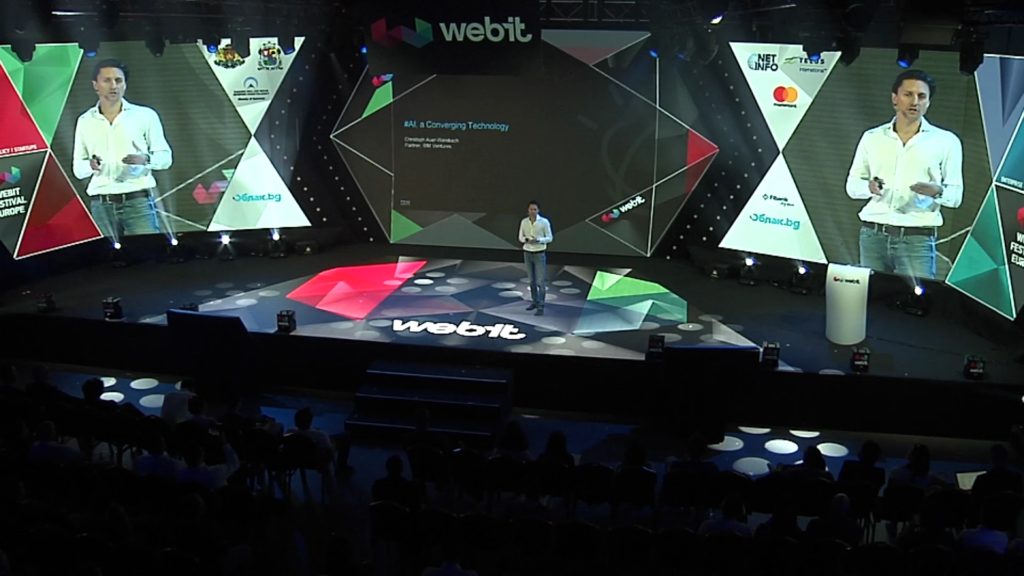 The Partner at IBM Ventures Christoph Auer-Welsbach.[/caption]
Christoph Auer-Welsbach predicts that there are 3 paradigms that are going to shape our communication with AI enabled computers in the near future.
The first is that enterprise applications and all the major IT organizations in the world will make use of any kind of conversation methodology, bot or automating systems, in the next couple of years. So our whole way of interacting with machines is going to change from input-driven to engagement and conversation-driven.
The second paradigm AI is pushing is mass individualization. Now we are living in a world where applications and solutions are built to satisfy the most common and homogenous group of people and reach them. The mass standardization we can see now is changing to mass personalization in a way that not only from a customer service view, but also from a product development and engagement point of view machines will be very much personalized on a person’s behavior, demand and attitude.
The third is that we are moving to the world of AI-enabled Convergence. It enables other technologies to flourish and get into the system contextual information and act proactively and not from a passive response point of view.
Artificial Intelligence is still in its infancy. That is why we need to be active and have the curiosity to understand what it is. It is important for every person on Earth to check the latest trends in this technology and understand how it could impact our personal and business life.
The Partner at IBM Ventures Christoph Auer-Welsbach.[/caption]
Christoph Auer-Welsbach predicts that there are 3 paradigms that are going to shape our communication with AI enabled computers in the near future.
The first is that enterprise applications and all the major IT organizations in the world will make use of any kind of conversation methodology, bot or automating systems, in the next couple of years. So our whole way of interacting with machines is going to change from input-driven to engagement and conversation-driven.
The second paradigm AI is pushing is mass individualization. Now we are living in a world where applications and solutions are built to satisfy the most common and homogenous group of people and reach them. The mass standardization we can see now is changing to mass personalization in a way that not only from a customer service view, but also from a product development and engagement point of view machines will be very much personalized on a person’s behavior, demand and attitude.
The third is that we are moving to the world of AI-enabled Convergence. It enables other technologies to flourish and get into the system contextual information and act proactively and not from a passive response point of view.
Artificial Intelligence is still in its infancy. That is why we need to be active and have the curiosity to understand what it is. It is important for every person on Earth to check the latest trends in this technology and understand how it could impact our personal and business life.
“We now use AI in situations where we didn’t have any solution yet - where technology is not capable of achieving specific results. We are putting a lot of efforts, time and resources to get there. What we have proved already is that we can solve complex, but narrow problems”, he said.The first demonstration of a machine that was capable of solving a complex problem was in 1997 when IBM’s Deep Blue defeated Garry Kasparov in chess. Roughly 15 years later a team in IBM Research had the goal to understand natural human language. The public demonstration was to defeat a human at the show Jeopardy and this was accomplished. Another thing that happened last year was Alpha Go from Google DeepMind defeating Lee Sedol in the boardgame Go and also succeeding to solve a very complex problem in a very narrow domain. And just recently a team from Carnegie Mellon University succeeded in developing a smart machine that has defeated world class poker players in Texas Hold ‘Em because it can already understand and deal with incomplete information. This all means that the future goes into the direction where AI will be used for negotiation processes, strategy development and even high level policy analytics.
“When you go to your car dealer in the future you may have a small application on your device that helps you negotiate the best possible deal”, Auer-Welsbach said.The biggest issue before the AI today is understanding humans and language. The machines understand natural text as data, not as text. This is a problem, because they are missing the context, which is necessary in order to really make use of all the data. In a recent attempt IBM broke industry record in conversation speech recognition by getting it down to 5.5%. This is important because the human error is at 5.1% which means that we are very close to understanding the natural human language from a machine perspective. This new ability can be used to build transformative relationships between humans and machines. [caption id="attachment_5072" align="aligncenter" width="640"]
 The Partner at IBM Ventures Christoph Auer-Welsbach.[/caption]
Christoph Auer-Welsbach predicts that there are 3 paradigms that are going to shape our communication with AI enabled computers in the near future.
The first is that enterprise applications and all the major IT organizations in the world will make use of any kind of conversation methodology, bot or automating systems, in the next couple of years. So our whole way of interacting with machines is going to change from input-driven to engagement and conversation-driven.
The second paradigm AI is pushing is mass individualization. Now we are living in a world where applications and solutions are built to satisfy the most common and homogenous group of people and reach them. The mass standardization we can see now is changing to mass personalization in a way that not only from a customer service view, but also from a product development and engagement point of view machines will be very much personalized on a person’s behavior, demand and attitude.
The third is that we are moving to the world of AI-enabled Convergence. It enables other technologies to flourish and get into the system contextual information and act proactively and not from a passive response point of view.
Artificial Intelligence is still in its infancy. That is why we need to be active and have the curiosity to understand what it is. It is important for every person on Earth to check the latest trends in this technology and understand how it could impact our personal and business life.
The Partner at IBM Ventures Christoph Auer-Welsbach.[/caption]
Christoph Auer-Welsbach predicts that there are 3 paradigms that are going to shape our communication with AI enabled computers in the near future.
The first is that enterprise applications and all the major IT organizations in the world will make use of any kind of conversation methodology, bot or automating systems, in the next couple of years. So our whole way of interacting with machines is going to change from input-driven to engagement and conversation-driven.
The second paradigm AI is pushing is mass individualization. Now we are living in a world where applications and solutions are built to satisfy the most common and homogenous group of people and reach them. The mass standardization we can see now is changing to mass personalization in a way that not only from a customer service view, but also from a product development and engagement point of view machines will be very much personalized on a person’s behavior, demand and attitude.
The third is that we are moving to the world of AI-enabled Convergence. It enables other technologies to flourish and get into the system contextual information and act proactively and not from a passive response point of view.
Artificial Intelligence is still in its infancy. That is why we need to be active and have the curiosity to understand what it is. It is important for every person on Earth to check the latest trends in this technology and understand how it could impact our personal and business life.
“The symbiosis between humans and machines is the most capable way of making use of technology and moving forward into the future. Because we can enhance each other’s capabilities. On the one hand we have human’s capabilities like compassion, intuition and value judgement and on the other we have the learning, discovery and fact checking that machines excel at”, the expert said.You may watch Christoph Auer-Welsbach’s full lecture here: If you want to keep up with the latest trend in the world of digital economy and technology, then Webit.Festival is the right place for you. Visit our website and book 2 of our Super Earlybird tickets for Webit.Festival Europe 2018 for just €100. Feel the Webit vibe with some of the best photos from this year’s event! [easingslider id="4954"]

